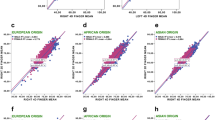Abstract
The ratio between 2nd and 4th digit length (2D:4D) may be a negative correlate of prenatal testosterone. This possibility has led to a number of studies of 2D:4D and its relationship with sexual orientation and other sex-dependent traits. At first, 2D:4D ratio was calculated from measurements made directly on the fingers but recently a number of studies have used measurements from photocopies of the hands. Here, we compared finger lengths (2D, 3D, 4D, and 5D) and ratios obtained from these two measurement techniques. Our sample consisted of 30 homosexual men and 50 men and 70 women who were not selected for their sexual orientation. We found evidence that (1)2D:4D from photocopies tended to be lower than that from direct measurements, (2) there were differences in finger lengths such that 2D from photocopies tended to be shorter or equal in length to direct measurements, while 4D from photocopies tended to be longer or equal in length to direct measurements, (3) the sex differences in 2D:4D tended to be stronger for photocopy measurements, and (4) the pattern for length differences across 2D to 5D appeared to be different for homosexual men compared to men and women recruited without regard to sexual orientation. We conclude that there are differences in digit ratios obtained from photocopies and direct measurements, and these differences arise from length differences recorded from the different protocols. Therefore, 2D:4D ratios obtained from photocopies and direct measurements should not be combined within one study nor should they be used together in comparative studies. We suggest that finger length differences between the two techniques could result from the shapes of fat-pads at the tips of the fingers and these may be dependent on sex and sexual orientation.
Similar content being viewed by others
References
Alter, M. (1965). Is hyperploidy of sex chromosomes associated with reduced total finger ridge count? American Journal of Human Genetics, 17, 473.
Fink, B., Neave, N., & Manning, J. T. (2003). Second to fourth digit ratio, body mass index, waist-to-hip ratio, and waist-to-chest ratio: Their relationships in heterosexual men and women. Annals of Human Biology, 30, 728–738.
Lippa, R. A. (2003). Are finger-length ratios related to sexual orientation? Yes for men, no for women. Journal of Personality and Social Psychology, 85, 179–188.
Manning, J. T. (2002). Digit ratio: A pointer to fertility, behavior and health. New Brunswick, NJ: Rutgers University Press.
Manning, J. T., Barley, L., Lewis-Jones, I., Walton, J., Trivers, R. L., Thornhill, R., et al. (2002). The 2nd to 4th digit ratio, sexual dimorphism, population differences and reproductive success: Evidence for sexually antagonistic genes. Evolution and Human Behavior, 21, 163–183.
Manning, J. T., Henzi, P., Venkatramana, P., Martin, S., & Singh, D. (2003). Second to fourth digit ratio: Ethnic differences and family size in English, Indian and South African populations. Annals of Human Biology, 30, 579–588.
Manning, J. T., Scutt, D., Wilson, J., & Lewis-Jones, D. I. (1998). The ratio of 2nd to 4th digit length: A predictor of sperm numbers and concentrations of testosterone, luteinizing hormone and oestrogen. Human Reproduction, 13, 3000–3003.
Ponnudurai, R. (1999). Relevance of sequential development of dermatoglyphics to schizophrenia. Psychiatry Research, 89, 59–67.
Rahman, Q., & Wilson, G. D. (2003). Sexual orientation and the 2nd to 4th finger length ratio: Evidence for organizing effects of sex hormones or developmental instability? Psychoneuroendocrinology, 28, 288–303.
Robinson, S. J., & Manning, J. T. (2000). The ratio of 2nd to 4th digit length and male homosexuality. Evolution and Human Behavior, 21, 333–345.
Williams, T. J., Pepitone, M. E., Christensen, S. E., Cooke, B. M., Huberman, A. D., Breedlove, N. J., et al. (2000). Finger-length ratios and sexual orientation. Nature, 404, 455–456.
Author information
Authors and Affiliations
Corresponding author
Rights and permissions
About this article
Cite this article
Manning, J.T., Fink, B., Neave, N. et al. Photocopies Yield Lower Digit Ratios (2D:4D) Than Direct Finger Measurements. Arch Sex Behav 34, 329–333 (2005). https://doi.org/10.1007/s10508-005-3121-y
Received:
Revised:
Accepted:
Issue Date:
DOI: https://doi.org/10.1007/s10508-005-3121-y




